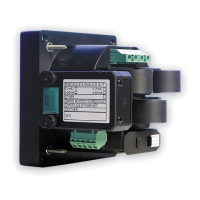6
2.5 Data Field
The data field contains information needed by the instrument to perform a specific function, or data
collected by the instrument in response to a query.
IMPORTANT Fields composed of two bytes are sent in the order high byte first, low byte second.
2.6 Error Check Field
The error check field contains the Cyclical Redundancy Check (CRC) word. The start of the message is
ignored in calculating the CRC. The CRC-16 error check sequence is implemented as described in the
following paragraphs.
The message (data bits only, disregarding start/stop and optional parity bits) is considered one continuous
binary number whose most significant bit (MSB) is transmitted first. The message is pre-multiplied by x
16
(shifted left 16 bits), and then divided by x
16
+ x
15
+ x
2
+ 1 expressed as a binary number
(11000000000000101). The integer quotient digits are ignored and the 16-bit remainder (initialized to all
ones at the start to avoid the case of all zeros being an accepted message) is appended to the message
(MSB first) as the two CRC check bytes. The resulting message including CRC, when divided by the same
polynomial (x
16
+ x
15
+ x
2
+ 1) at the receiver will give a zero remainder if no errors have occurred. (The
receiving unit recalculates the CRC and compares it to the transmitted CRC). All arithmetic is performed
modulo two (no carries).
The device used to serialize the data for transmission will send the conventional LSB or right-most bit of
each character first. In generating the CRC, the first bit transmitted is defined as the MSB of the dividend.
For convenience, and since there are no carries used in the arithmetic, let's assume while computing the
CRC that the MSB is on the right. To be consistent, the bit order of the generating polynomial must be
reversed. The MSB of the polynomial is dropped since it affects only the quotient and not the remainder.
This yields 1010 0000 0000 0001 (Hex A001). Note that this reversal of the bit order will have no effect
whatever on the interpretation or bit order of characters external to the CRC calculations.
The step by step procedure to form the CRC-16 check bytes is as follows:
1. Load a 16-bit register with all 1's.
2. Exclusive OR the first 8-bit byte with the low order byte of the 16-bit register, putting the result in the 16-
bit register.
3. Shift the 16-bit register one bit to the right.
4a. If the bit shifted out to the right (flag) is one, exclusive OR the generating polynomial 1010 000 000
0001 with the 16-bit register.
4b. If the bit shifted out to the right is zero, return to step 3.
5. Repeat steps 3 and 4 until 8 shifts have been performed.
6. Exclusive OR the next 8-bit byte with the 16-bit register.
7. Repeat step 3 through 6 until all bytes of the message have been exclusive ORed with the 16-bit
register and shifted 8 times.
8. When the 16-bit CRC is transmitted in the message, the low order byte will be transmitted first, followed
by the high order byte.
For detailed information about CRC calculation, refer to the Modbus Protocol Reference Guide.

